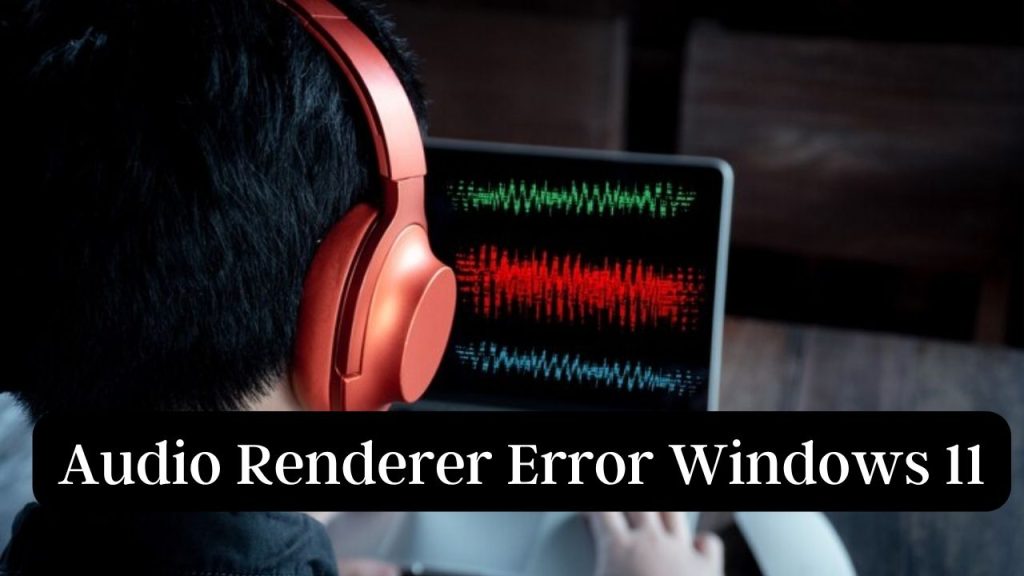The Audio Renderer Error Windows 11 is a frustrating, relatable problem that may silence your system out of nowhere. It generally displays a pop-up alert like an error Audio renderer. Please reboot your computer. A restart often makes things right but the issue crops up again later. This guide will show you some ways to fix your audio problem so it doesn’t ruin your experience.
Read: How to Skip Microsoft Account Setup in Windows 11
Understanding the Audio Renderer Error Windows 11
Before getting to the solutions, we will discuss what the Audio Renderer Error Windows 11 means. It just means that your Windows operating system is struggling to process or “render” audio to your playback device your speakers, headphones etc. This can occur for various reasons some of which are:
- Outdated or Corrupt Audio Drivers: this is the most common cause. Drivers are the pieces of software your hardware (like your sound card) uses to interface with your operating system (e.g. Windows) and to work with other hardware.
- The conflict caused by Software: There is some other software like virtual audio cable, audio enhancement or some third-party equalizers that can also conflict with the default sound of Windows.
- Windows Audio Service Related Problems: The main Windows Audio service, which is meant to manage audio on your system may be temporarily corrupted or in a stopped state.
- Incorrect Audio Device Settings: Your default playback device may be misconfigured or the sample rates may not be matching up.
- Hardware Issues: Drawing is less common but just as likely the problem could be a defective audio port, cable or perhaps the sound card.
Let’s now move on to the solutions.
Step-by-Step solutions on how to fix the Audio Renderer Error Windows 11
We begin with the easiest solutions and work our way up to more complex troubleshooting measures.
1. The Classic Restart (Temporary but Often Effective)
As the error message indicates there is just a need to restart to help with short-term bugs. This shuts down any lingering tasks or small software conflicts.
- Click on the Start button.
- Click on the Power icon.
- Select Restart.
After rebooting your PC check your audio. If the error comes back when you repeat the process move on to the next steps.
2. Reconnect Your Audio Device
There are times when the problem is as short-lived as a loose connection or a brief disruption with your connected audio equipment.
- For Wired Devices (headphones, speakers): Unplug from your PC and then plug it back in snugly. Plug it in various audio sockets if you have any.
- For Wireless Devices (i.e., Headphones, Speakers)Turn Bluetooth off on your computer and turn it back on.
- Navigate to Settings > Bluetooth & devices > Devices.
- Scroll down and find your audio device, then click the three dots next to i, and click Remove device. Then pair it again.
3. Reboot your Windows Audio Services
The Windows Audio service is an important part of sound playback. Sometimes, a simple restart can fix all your audio problems.
- Open the Run box by pressing Win + R.
- Type services. msc and press Enter.
- In the Services window, go down and find Windows Audio and Windows Audio Endpoint Builder.
- Right-click Windows Audio and click Restart. If it is not running, click on Start.
- Repeat the process for Windows Audio Endpoint Builder as well.
- Click OK > close the Services window and test your audio.
Update or Reinstall Audio Drivers
The most common cause of the Audio Renderer Error Windows 11 is outdated or corrupted audio drivers. Some Programs Just Need To Be Reinstalled Updating or reinstalling programs may be the most reliable fix.
4.1. Update Audio Drivers from Device Manager
- Right-click the Start button and choose Device Manager.
- Expand Sound, video and game controllers.
- Right-click your sound device (for example, Realtek High Definition Audio, NVIDIA High Definition Audio or Intel(R) Display Audio) and choose Update driver.
- Select Search automatically for the updated driver software.
- Follow the on-screen prompts.
4.2. Reinstall Audio Drivers
Reinstalling the driver may deliver a fresh start if updating fails to do the trick.
- Then in Device Manager right-click your audio device and uninstall the device.
- If available, check the box that reads “Attempt to remove the driver software for this device” and then click Uninstall.
- Restart your computer. Windows should be able to reinstall the Generic Audio Driver again once you reboot.
- Try to see if the issue is fixed after restarting. If not, then try to download the newest driver from the PC/motherboard manufacturer site or sound card manufacturer site (Realtek, Intel, NVIDIA, ASUS, HP).
4.3. Roll Back Audio Drivers
Occasionally the latest driver does the same.
- Right-click your audio device and select Properties in Device Manager.
- Go to the Driver tab.
- Click the Roll Back Driver button if it is available and follow the prompts. This will undo the most recent driver update.
5. Disable Audio Enhancements
Improvements to audio might have unintended effects on the quality of audio output.
- Right-click on the Volume icon on your taskbar and choose Sound Settings.
- Under “Output,” choose your main audio output device.
- Scroll down, then click More Sound Settings (you may need to click Volume Mixer first, depending on your version of Windows 11).
- Under Sound, click your playback device (e.g., Speakers) and click Properties.
- Go to the Enhancements tab.
- Check mark on Disable all enhancements or Disable all sound effects.
- Click Apply and then OK.
6. Sample Rate & Bit Depth
Audio Formats not matching up between your system and applications is one way the Audio Renderer Error Windows 11 can arise.
- Follow steps 1-4 from “Disable Audio Enhancements” to locate the Properties of your playback device.
- Go to the Advanced tab.
- In the “Default Format,” try a different sample rate/bit depth (24 bit, 48000 Hz to 16 bit, 44100 Hz – or the opposite).
- Click Apply and OK to apply the changes and play some audio to check it works. P.S. If you own ASIO drivers make sure their sample rate is set to what windows are set to.
7. Run the Troubleshooter of Audio Renderer Error Windows 11
Windows has built-in troubleshooters that can automatically find and fix common problems.
- Go to Settings > System > Troubleshoot.
- Select Other troubleshooters.
- Locate Playing Audio and select it Run.
- Just follow the prompts on your screen.
8. Disable Exclusive Mode
Exclusive mode can be taken over by certain applications and that can lead to conflicts.
- Follow steps 1-4 of “Disable Audio Enhancements” to access the Properties of your playback device
- Go to the Advanced tab
- In “Exclusive Mode” click to uncheck both boxes
- Give exclusive mode applications priority on this device
- Prioritize exclusive mode apps
- Click Apply and OK
9. Check for conflicts with third-party audio software
There are a few different software that can cause conflicts like VoiceMeeter, Equalizer APO or other audio mixers/equalizers.
- If you’ve recently installed a new audio software of any kind try uninstalling it for some time to see if the problem vanishes.
- You can also do a Clean Boot and see if any third-party application is conflicting with it or not. (Search”> Clean Boot Windows 11” for instructions)
10. Update Windows 11
Note that Microsoft will occasionally push fixes for known issues through Windows updates. Keeping your system updated with the latest updates is a good idea regardless.
- Go to Settings > Windows Update.
- Click on Check for updates, and continue with the installation of any updates available to you.
Conclusion
The Audio Renderer Error Windows 11 is no funnies however by sequentially working your way through these troubleshooting steps, you will greatly improve your chances of fixing it. And always begin with the easy solutions and then move on to the hard ones. If not replacing or restarting your audio drivers or resetting the Windows Audio service should help.



